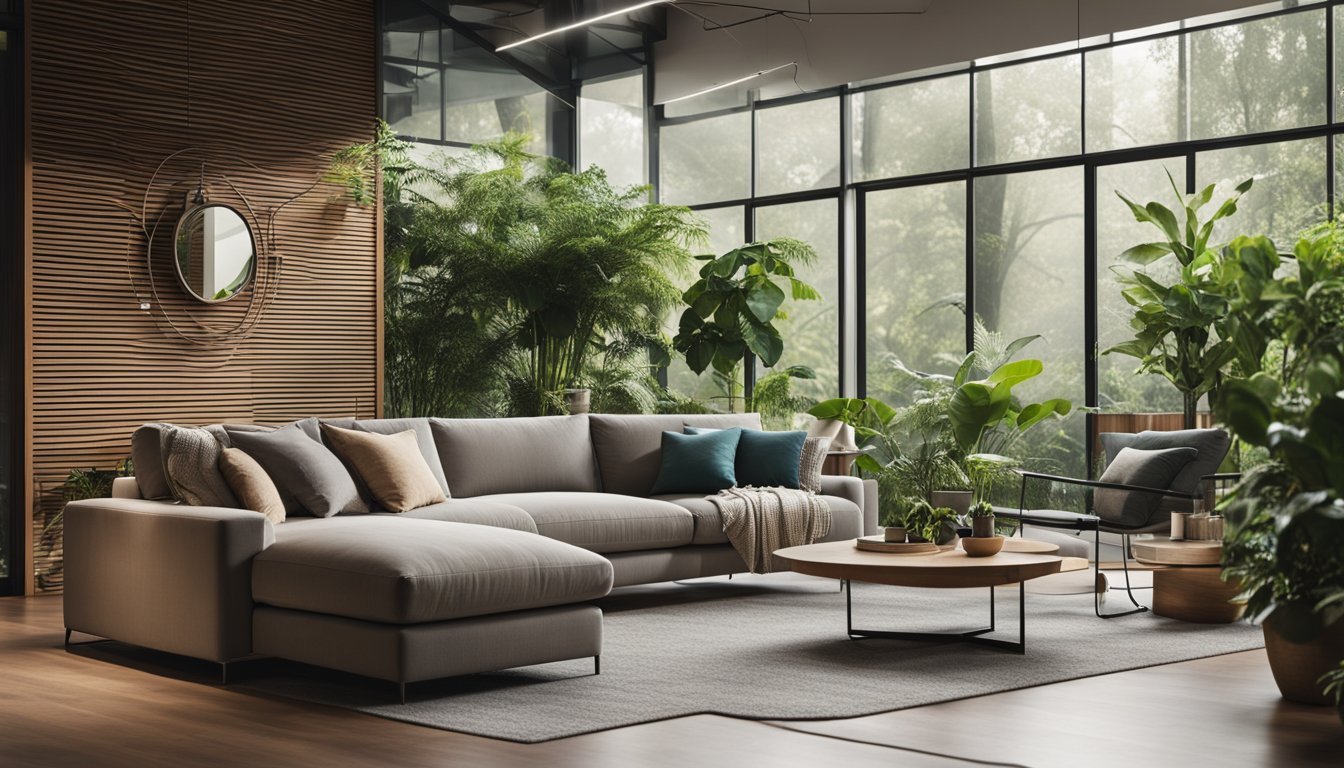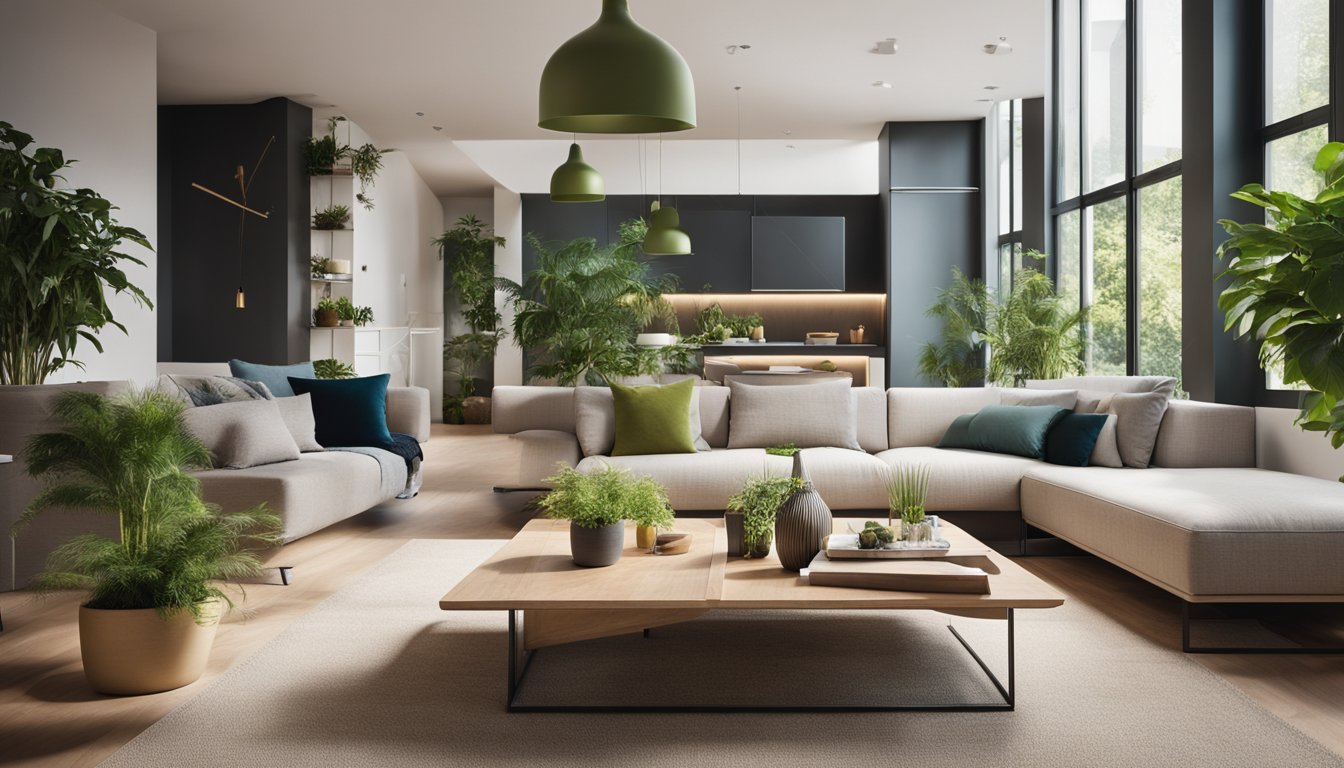Late updated: 26 Apr 2025 14:04
Written by: Daniel Harper
Innovative Sustainable Interior Design Ideas: Transforming Your Space with Eco-Friendly Solutions
In recent years, sustainable interior design has moved beyond mere trends to become a core philosophy in creating living spaces that combine aesthetics with environmental responsibility. Our team is passionate about uncovering ways to craft interiors that not only look good but are also kind to our planet. We believe innovative sustainable design can transform any home into a haven that respects the Earth while exuding modern charm.

Adopting sustainable design principles involves using materials that are renewable, biodegradable, and sourced responsibly. Whether it's choosing rattan, bamboo, or organic cotton, these choices reflect a deeper commitment to eco-friendly living. Embracing these materials opens doors to unique and stylish interiors without compromising on sustainability.
Furthermore, innovation in sustainable interior design includes repurposing existing furniture and incorporating advanced technologies that reduce energy consumption. We are excited to explore how these innovative ideas can redefine our living spaces, offering both functionality and sustainability as standard components.
Key Takeaways
- Innovative sustainable design merges eco-friendliness with modern aesthetics.
- Materials like bamboo and organic cotton are central to eco-focused interiors.
- Repurposing and technology enhance sustainability at home.
Principles of Innovative Sustainable Interior Design
In our exploration of innovative sustainable interior design, we emphasise reducing environmental impact, addressing greenwashing, and implementing carbon reduction strategies. These principles are vital for creating interiors that benefit both people and the planet.
Defining Sustainable Interior Design
Sustainable interior design involves crafting interior spaces that prioritise environmental responsibility. At its core, it seeks to balance aesthetics with ecological impact.
Designers choose organic and recycled materials to minimise resource depletion. Selecting products with low volatile organic compounds (VOCs) enhances indoor air quality, contributing to a healthier living environment. Integrating renewable energy solutions, like solar panels, can also play a significant role.
Ultimately, it is about creating spaces that not only look good but are also good for the environment.
Minimising Environmental Footprint Through Design
One of the key components of sustainable living is reducing the environmental footprint through thoughtful design. By employing strategies that conserve resources, designs not only reduce waste but also promote energy efficiency.
Using natural light can cut down on electricity usage. Incorporating energy-efficient appliances and fixtures, such as LED lighting and low-flow water systems, contributes significantly to conservation efforts.
Furthermore, selecting materials that are locally sourced not only supports local economies but also reduces the carbon footprint associated with transportation.
Key Strategies for Reducing Carbon Footprint
Reducing the carbon footprint in interior design involves careful planning and selection of eco-friendly materials and methods. Designers might opt for carbon-neutral materials or those with minimal carbon output during production.
Reusing and recycling existing materials or furniture also contributes to carbon reduction. Creating multifunctional spaces can further optimise the use of resources.
These strategies are instrumental in decreasing the overall carbon emissions related to interior projects, paving the way for a greener future.
Avoiding Greenwashing in Sustainable Interiors
Greenwashing, the practice of misleading consumers about the environmental benefits of a product or service, poses a significant challenge in sustainable design. It’s crucial for us to remain vigilant in identifying and avoiding it.
Authenticity is key. We need to ensure that products truly meet sustainability standards through independent certifications like BREEAM or Energy Star. Transparency in supply chains and production processes is also vital.
By committing to genuine sustainable practices and avoiding superficial claims, we can build trust and lead the way in truly sustainable interior design.
Innovative Sustainable Interior Design Ideas for the Modern Home

Our modern homes can blend innovation with sustainability through strategic design choices. By integrating natural and repurposed materials, optimising energy efficiency, and making creative use of eco-friendly furnishings, we can achieve a space that is both stylish and sustainable. Let's delve into these key design areas further.
Incorporating Natural and Repurposed Materials
Utilising natural materials like wood and stone not only adds aesthetic value but also promotes sustainability. Reclaimed wood is perfect as it reduces demand for new wood production. Using reclaimed materials can transform history-rich wood into stunning furniture pieces and flooring.
Recycling materials also plays a significant role. Recycled glass can be transformed into beautiful countertops or decorative accents. Opting for fabrics like linen and cotton, alongside earthy tones, brings a natural beauty to the home. This approach not only preserves resources but also enriches our interiors with diverse natural textures.
Maximising Energy Efficiency in Interiors
Energy-efficient homes benefit our environment and lower utility bills. LED bulbs are a staple, providing light with less energy consumption. Implementing smart thermostats can optimise heating and cooling, adjusting based on activity and preferences. They are an easy way to maintain a comfortable atmosphere while conserving energy.
In the living room and other spaces, energy-efficient lighting solutions enhance ambiance without excessive power use. This includes task lighting and ambient fixtures that achieve the desired brightness while prioritising sustainability.
Creative Use of Eco-Friendly Furnishings and Décor
Selecting furnishings crafted from eco-friendly materials is crucial. Bamboo and recycled materials create stunning and sustainable options for furniture and decoration. Multi-purpose furniture pieces designed with versatility and creativity add sophisticated functionality to any space.
By embracing natural materials, we ensure minimal environmental impact. Artisanal craft pieces showcase intricate patterns and craftsmanship, enhancing our home's character. Each eco-friendly choice supports a sustainable home.
Enhancing Health and Well-being Through Biophilic Design
Biophilic design is key to promoting health and well-being. Introducing indoor plants enhances indoor air quality and brings a touch of nature inside. The presence of greenery calms and rejuvenates.
Incorporating natural elements such as water features or even artwork inspired by nature enhances the sensory experience. These additions not only beautify our homes but also nurture our connection to the outdoors, fostering a balanced living environment.
Sustainable Bathroom and Kitchen Solutions
Our kitchens and bathrooms can benefit from sustainable upgrades. Water-saving fixtures, such as low-flow taps and showerheads, drastically reduce water consumption without sacrificing performance. Using sustainable materials like recycled glass for countertops and tiles helps further.
In the sustainable bathroom, opting for low-VOC paints and finishes contributes to healthier indoor environments. These upgrades extend to all aspects of our home redesigns, creating spaces that are both eco-conscious and modern.
Smart Technology for Sustainable Homes
Smart technology is an asset in achieving a sustainable home. From smart thermostats to automated lighting systems, these innovations optimise energy use, making sustainability a seamless part of daily life. Through smart integration, our homes become more responsive to our needs and more efficient.
Additionally, incorporating systems that monitor and manage energy consumption provides insights that help us make informed decisions, leading towards a future where technology and sustainability go hand in hand.
Frequently Asked Questions

In the realm of sustainable interior design, new trends are continually surfacing. Unique materials and practices offer practical solutions for eco-friendly spaces. By incorporating these into our projects, we can make significant strides toward environmental preservation.
What are the emerging trends in eco-friendly interior design?
Eco-friendly interior design is seeing a rise in popularity of reclaimed and recycled materials, such as reclaimed wood and recycled metal. These materials are celebrated for their ability to add a touch of elegance while maintaining sustainability.
How can interior designers incorporate sustainability into their projects?
Interior designers can incorporate sustainability by opting for energy-efficient lighting and utilising natural light. Selecting materials with a lower environmental impact, and focusing on designs that promote energy conservation, also play a crucial role in sustainable projects.
What are some practical examples of sustainable interior design practices?
Practical examples include using non-toxic paints and finishes, which contribute to healthier indoor air quality. Additionally, furniture made from recycled materials offers style and function while supporting a sustainable ethos.
Can you suggest some sustainable materials for eco-conscious interior decoration?
Sustainable materials for interiors include bamboo, cork, and hemp. These options are not only renewable but also provide a stylish and durable choice for various design elements in the home.
In what ways do sustainable interior design concepts contribute to environmental preservation?
Sustainable interior design concepts help reduce waste by promoting the use of recycled and upcycled elements. They also support energy efficiency, reducing overall carbon footprints and promoting environmental conservation.
What are the benefits of integrating sustainable features into interior design?
Integrating sustainable features can lead to reduced energy costs and improved indoor air quality. Moreover, these practices encourage recycling and waste reduction, ultimately contributing to a healthier environment for us all.
